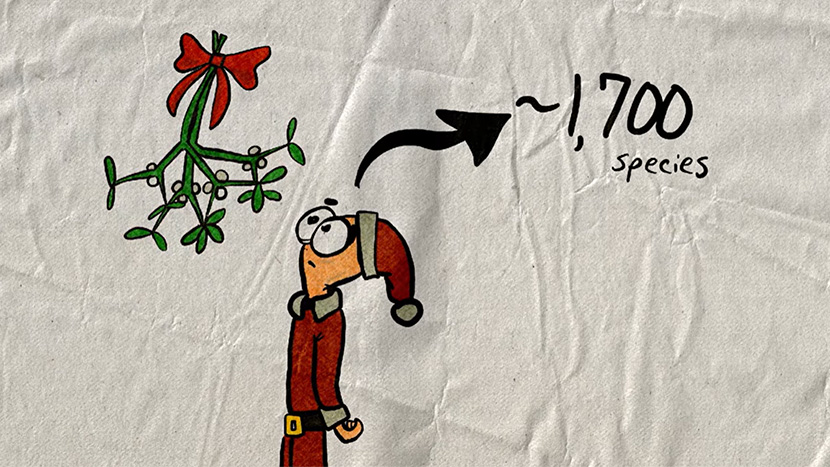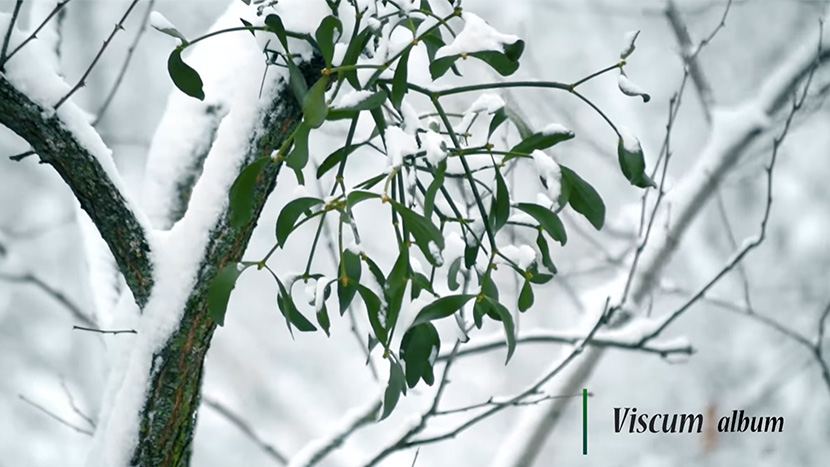So, what is mistletoe exactly?!

Have you ever been enjoying a festive holiday party and been invited for a kiss under a toxic and parasitic plant? If you think the answer is no, you might be surprised!
That’s right, mistletoe, which is often mistakenly misrepresented by holly plants instead, is a really interesting plant, which depending on the species can be a tasty snack, or a very toxic one. So what is mistletoe exactly?
What is mistletoe?
Mistletoe is not a taxonomic grouping of plants, but instead a group of 1,700 different species with a similar life strategy! the way that mistletoe grows and survives, that has evolved five separate times!
Mistletoe are evergreen, woody, hemi-parasites that grow on trees. They are considered hemi-parasitic because they are still green plants that get energy from the sun (unlike parasitic ghost pipes for example) but they do take some nutrients and water from their host plant. Now, despite the fact that too many mistletoe could potentially kill a tree, experts like @D0CT0R_dave reassure us that they often do little damage to the trees. In fact, they are quite beneficial to the ecosystem and are a really important food source for birds; some species are great for people too!

Which mistletoe is toxic and which mistletoe is safe?
Most people think that mistletoe fruit is toxic, and though this is true for the most famous kind from Western Europe – Viscum album – and surely some other varieties, the American mistletoe, Pharadendron leucarpum, is actually really delicious!
Interestingly, the lectins in Viscum album that make it so toxic can be used as cancer treatment! This is because lectins can cause cell death, but used in the right way are an anti-tumor compound! Mistletoe lectins are currently used as modern cancer treatment in Europe and are being researched more every day!
Benefits of American mistletoe
The American mistletoe is a delicious snack and has formed a part of Native American diets for a long time. Mistletoe fruit is good for you because it contains:
- Carbohydrates
- Beneficial lipids
- Essential amino acids
The American mistletoe does also contain phoratoxins which can be dangerous, but these are found in the stems and leaves, meaning you don’t want to try to make a tea with them!

Why do we kiss under the mistletoe?
Just like a lot of old legends that have spread around the world, there are many varieties of the origin of kissing under the mistletoe. Some of the two most common ones are these:
Norse mythology says that Baldur, son of the goddess Figg, was killed by a poison mistletoe arrow. After his death, Figg wanted to make mistletoe a sign of peace, instead of allowing it to be used as a weapon. So, she made mistletoe a sign for love and peace and people would kiss beneath it from then on.
There are also ideas that mistletoe represented love and fertility. The fact that mistletoe stays evergreen through the long cold winter, while everything else appears dead, made it a symbol of fertility. Essentially, kissing under it was good luck for couples hoping for children.
We may never know the true origin of the kiss-under-the-mistletoe tradition, but it is also likely that it has multiple origins, just like mistletoe itself! Either way, it is a romantic tradition to keep alive during the winter holidays, just make sure you aren’t using holly by mistake!

How to propagate mistletoe
Mistletoe can be an attractive addition to your yard and can help feed birds through the winter, so if you decide you would like to have mistletoe on your property, here are the steps to propagate it:
- Make sure you find a local and native variety
- Find a squishy fruit, if it is too hard it won’t work!
- Pick a well-lit side of your tree
- Find a pencil-thick branch
- Squish your fruit and place the sticky seeds on the underside of the branch
- Wait for your mistletoe to start growing!
So, next holiday when you see a mistletoe, you can try and use these interesting mistletoe facts to see if you can woo someone for a kiss under this intriguing evergreen parasite.

